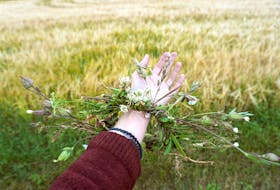A growing number of people praise the health benefits of switching from commercially processed pet foods to raw meat-based diets.
But many vets disagree raw foods are best, saying science is not backing these claims.
Karen Overall, associate professor at the Atlantic Veterinary College (AVC) in Charlottetown, PEI, said people feed their pets raw diets because they believe it is "healthier" and closer to what "nature intended" and more "ancestral" - but dogs are now domesticated.
"No favourable behavioural effects of raw diets have ever been documented. There is no evidence for raw diets being 'healthier,' and researchers have specifically looked. Dogs fed raw diets have smaller amounts of feces and a different microbiome than those provided standard diets, but there is no published evidence of actual health improvement effects," she said.
"Furthermore, recent research has illuminated genetic changes in modern dogs that show how similar their metabolism is to humans."
Overall argues that modern commercial diets are "specifically formulated to meet the physiological, health and performance needs of companion animals and to address deficiencies that develop with some pure meat or fish diets, and poor-quality foraged diets."
Raw diets are also at risk from several bacterial contamination events, she said.
"There is an increasing problem with antibiotic resistance. High incidences of salmonella, E. Coli, and clostridia are found in these diets – all bacterial pathogens for people and their pets. Clients must know that even with exquisitely careful handling, these diets are more risk than commercial diets to cause bacterial illness."
Overall stressed that immune-compromised people (for example, cancer patients or those with auto-immune diseases), babies and young children, the elderly, and anyone with severe chronic illness should not handle raw products.
"If anyone in the household falls into any of these categories, the public health and veterinary research data support complete avoidance of raw diets, at all costs."
Risk levels?

Janice Crowell, a seller of raw pet food in Nova Scotia, said ’‘the risks of harmful bacteria are reasonably low for a healthy dog."
"Bacteria can just as easily contaminate kibble, as we often see with recalls. Proper sanitizing protocols must be adhered to in the same way you would sanitize after preparing meat products for our (human) consumption," said Crowell.
"If surface bacteria are the customer's major fears, but they appreciate the benefits outside of those risks, we may recommend a dehydrated or freeze-dried option instead. I would not argue that raw feeding is 'best' because I advocate for finding what works best for the individual pet. It isn't for everyone, and it's not for every dog."
While some raw diets are mass-produced like a commercial kibble or canned food, reputable companies offer independent and external testing to ensure quality and safety, says Crowell.
"Home-cooked meals have less oversight, but human error is also a risk factor. It's important to have an in-depth understanding of nutrition and ensure you create an appropriately balanced diet or run the risks of potentially life-threatening deficiencies," Crowell said.
Raw foods contain approximately 80 per cent muscle meat, 10 per cent bone content, and 10 per cent organ, explained Crowell.
"Out of the organ meat, approximately half needs to come from the liver to include necessary enzymes. This organic material makes up the average dog's basic health needs without further supplementation – protein from the muscle meat, vitamins, minerals, and enzymes from organ content; calcium and phosphorus from the bone."
She added omegas come from fish, eggs, or oil additives necessary for the diet.
The case for raw

Pet parents across the East Coast tout online about the benefits of transitioning to raw diets, saying their canines have dramatically improved in health, quality of life, and more.
Marie-Josee Morrier of Halifax, N.S. said after a recommendation by her vet, she switched to a raw diet and the difference was noticeable.
"I have three dogs: a 10-year-old cocker spaniel and two rottweilers (ages two and four). I started feeding them a raw diet four years ago after my one rottweiler suffered from bladder infections. I began with patties made from grounded vegetables and raw bones," she said.
The changes were obvious, she adds.
"I noticed after switching the diet, my rottweiler had no more bladder infections, and all their coats became shiny, and the dogs were leaner and healthier."
Since switching diets, Morrier argues against commercial kibble and canned foods for pets.
"There are so many additives in it (kibble), and after reading a lot about commercial food, I have no hesitation feeding raw," she says.
It is a costly choice, she acknowledges.
"I use 10 patties a day, so it is over $500 a month. I switched to a 'mega dog raw' from Jollytail, and you can buy this in a variety pack – chicken, beef, pork, and turkey."
Raw diets can cost a 50 pound dog around $100 to feed per month, depending on age, activity level, and food type, says Crowell.
Lexi Whyte, the owner of On Cue Animal Training in Halifax, argues commercial foods contain "carbohydrates, preservatives, and fillers," which causes several health problems for pets.
"Yeast infections, allergies, excess stool, itching, body odour, tear stains, ear infections, bad breath, thin and dull coat, low energy, obesity," she lists as some of the issues she's seen.
"Raw food is the best for cats and dogs as long as it comes from a balanced source. Homemade natural dog food could cause nutritional deficiencies if not done correctly, but it is less processed and is more biologically appropriate."
Kibble is full of carbohydrates, she points, out, which are not the best choice for pets.
"Carbs are OK in small amounts for dogs but are dangerous for cats (obligate carnivores). Carbs are not an essential part of a pet's diet, yet they are one of the main ingredients in all dry dog foods (50 per cent to 75 per cent)," Whyte says.
"Pet foods include carbs because it increases the food shelf life, inexpensively adds calories, makes the animals feel fuller with less food."
Did you know?
The U.S. Centers for Disease Control and Prevention (CDC) does not recommend feeding raw diets but offers the following tips to stay healthy while handling this food:
- Wash hands with soap and water after handling
- Clean and disinfect all surfaces the raw food touched
- Freeze raw pet food until ready to use
- Keep raw pet food away from human food
- Do not thaw frozen raw pet foods on a countertop or in a sink
- Throw away any food the pet does not eat
- Do not let the pet lick around your mouth, face, wounds, or broken skin after eating
- Wash hands after playing with a pet that has just eaten
- Do not use the feeding bowl to scoop food but a rather a clean, dedicated scoop or cup
- Always follow storage instructions on pet food bags or containers
Mandi Boucher, owner of Nova Starrs Kennels in Canning, NS, said she switched to raw because her pomeranian dogs "hated" kibble.
"I own nine adult poms, four juniors, and currently have two litters. All raised on raw – weights from three pounds to seven pounds. When I fed kibble, I fed the higher-quality brands, averaging about $60 to $80 every week or so. When I feed raw, I buy pre-made raw that is already blended and balanced. I spend $17 to $30 roughly a day," she says.
Then she adds extras.
"I add my organic eggs, frozen sardines, organic coconut, Kiefer, and sometimes I add fish oils. I always add an organic dental powder to the food to help keep teeth in tip-top shape. I offer the dogs water with colloidal silver three times a week, and homemade pumpkin treats whenever needed (fibre)," she says.
"Raw has brought in much better fur coats. I have less dental build-up; all dogs are perfect weights; their appetite for meals is always great. I have raised toy pomeranian puppies for 10 years and have seen a dramatic change in the past 16 months of feeding raw over every other diet I've tried."
What's best?
Raw versus kibble can be a heated debate when it boils down to what is best for Fido.
"Discussing diet in dogs can be a lot like discussing religion and politics," Overall said, while noting owners should have a consultation with a veterinary nutritionist first for the best diet.
"If anyone – human, cat, dog – develops any vomiting, diarrhea, extreme flatulence, abdominal pain – seek medical and veterinary help. Very few veterinarians approve of raw food diets, and pet owners know this. If anyone is ill, please tell your vet you are feeding a raw diet. It could save the pet's life."









